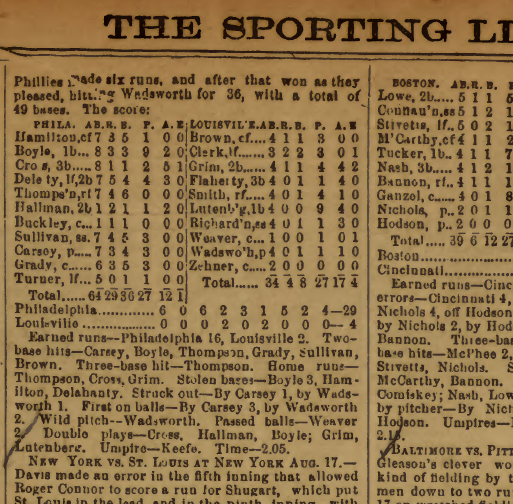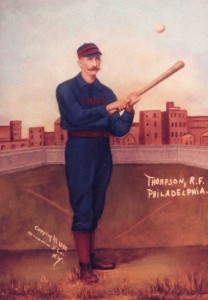Historical Hitter August 17 1894: Sam Thompson
With Michael Cuddyer hitting for the cycle yesterday was one of baseball’s exceptional performances and it became the theme of the day.
Four other players also hit for the cycle on August, 17: Mark Teixeira (Rangers) in 2004, Jeff Frye (Blue Jays) in 2001, Earl Averill (Indians) in 1933, and “Big Sam Thompson in 1894. Curry Foley was the first Major leaguer to hit for the cycle on May 25, 1882.
That second and third weeks in August from the August 8th to the 22nd seem to be the season for hitting for the cycle 14 players had accomplished it during this time, in fact 45 players hit for the cycle in August.
But today’s Hitter in History was the first player to hit for the cycle on August 17: Big Sam Thompson. He was born in 1860 and played 15 seasons in the majors, 10 of them with the Phillies. He batted left-handed and was a noted low ball hitter with power and speed. He was an excellent fielder too and was a feared right fielder with perhaps the strongest arm of his time. 1894 was his best year. That year along his fellow Phillies outfielders and Hall of Famers Ed Delahanty in left and Billy Hamilton in center all hit above .400. Even their backup Tuck Turner hit .414! This was baseball’s best hitting team of the 19th century, as Baseball-reference notes the poorest batting average of the starting eight position players was Jack Boyle who hit a measly .298. William Connelly wrote in Baseball Magazine of August 1915, “Yes, the old Phils packed a prodigious punch.”
Park factors surely helped push their averages up, as they played in three parks, the first wooden Huntingdon Grounds I & II. The old wooden grandstand burned down mid-season on August 8th and was quickly rebuilt and reopened ten days later simply just to finish the season. The original dimensions of the Huntingdon Grounds I were 500 feet in left and center and a mere 310 down right field line. Later, the new dimensions were transformed into the band-box Baker Bowl dimensions of 350-408-280. The wall in right field dwarfed the green monster- its first configuration came in at 40 feet, and by the time the Phils abandoned this inadequate place, in 1938, it grew to 60 feet high. During the construction period interim the Phils played six games, two against the White Sox and four vs. the old Louisville Colonels at the University of Pennsylvania’s athletic field – no dimensions are available for this field, but the runs scored indicate it was inadequate. In this six game stretch those prodigious power punching Phils scored 93 runs, an average of 15.5 runs per game.
The game of August 17th was the record setting game the Phillies treated the Colonels pitcher as a batting practice dummy and racked up 29 runs and 36 hits, all against one pitcher, Jack Wadsworth. Wadsworth pitched a total of four seasons with a career record of 6-38 with an ERA of 6.85 and a WHIP of 2.104. Perhaps part of the his pitching deficiency rests in the rule change that the moved the mound back 5 feet to its current 60 feet-6 inches in 1893.
Thus we had the perfect storm situation for the pitchers and the ideal situation for the hitters: poor starting pitching and a new pitching mound distance, Hall of Fame Hitters, and an interim, inadequately sized ball park.
Yet, the game notes tell us that the Phillies first 6 runs were scored with two outs as a result of a blown call– a failed third strike call in the first inning. Only if Louisville had instant replay in 1894! The Phillies, according to Sporting Life, “after that won [sic] as they pleased.” For the record Sam Thompson went 6 for 7, three singles, a double, triple and home run, a grand total of 14 total bases. Fellow Hall of Famers Hamilton went 5 for 7 and a walk and 3 runs and Delahanty went 4 for 7 with a walk and 5 runs scored.

By all accounts Big Sam was a gentleman on the field, a larger than life person, very popular and after baseball active in civic life and a stalwart in the community. In his SABR Bio by Don Thompson, Sam was noted as:
… he was never ejected from a game, involved in a fight, or suspended by the National League during an era known for rough play and rough players. At Sam’s funeral, his friend Charlie Bennett said, “He was a wonderful friend. No one ever quarreled with Sam. No one ever knew him with all his strength to be rough or brutal. He was always even tempered, simple and plain.”
He was a physical giant in the game being 6-2 and powerful, weighing over 200 pounds. His first team, the old Detroit Wolverines, did not have a uniform large enough for him. Sam suffered the indignity of splitting his too small issued pants legging out a double.
He also was firm with management and negotiated the highest salary allowed at the time. Sam publicly announced that he would not resign with the Phillies because, unlike that standard of the day, they did not travel in parlor cars and stay in ten dollar-a-day hotels. The Sporting Life magazine noted that Sam is so popular… “that the club will not let him go without a struggle” (Vol 22, No. 18 Jan 27, 1894.)
He died in November 1922 to the dismay of Detroit and lead to an informal day of mourning for the city with city courts, factories and businesses stopping as a sign of respect.
He did not become a Hall of Famer until 1974 being selected by the veterans committee. And with that recognition a new monument was placed at his gravesite in Detroit, he became the first baseball player to have a plaque dedicated by the state of Indiana, and his home town of Danville, named their little league field after him.
Sources:
Sporting Life Magazine, Vol 22, No. 18 January 27, 1894
Vol. 23 No. 21 August 18, 1894
Vol. 23 No. 22 August 25, 1894
SABR Baseball Bio Project http://sabr.org/author/don-thompson
Baseball-almanac.com
Baseball-reference.com
Baseball Magazine, William Connelly, 1915 August, Vol. XV No. 4 p. 37-40.

